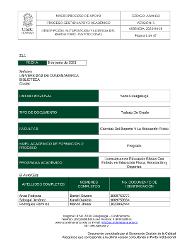| dc.contributor.author | ARIZA PEDRAZA, DANIEL STIVENS | |
| dc.contributor.author | SABOGAL JIMÉNEZ, KAROLL DANIELA | |
| dc.contributor.author | RODRÍGUEZ RAMÍREZ, CARLOS JHOAN | |
| dc.date.accessioned | 2021-08-31T19:33:17Z | |
| dc.date.available | 2021-08-31T19:33:17Z | |
| dc.date.issued | 2021-08-31 | |
| dc.identifier.uri | http://hdl.handle.net/20.500.12558/3611 | |
| dc.description.abstract | La población infantil está afectada en su desarrollo psicomotor por el alto nivel de sedentarismo,
el cual provoca enfermedades físicas y mentales que antes solo se veían en personas mayores;
con los datos de una valoración motriz adecuada, es posible iniciar procesos desde la actividad
física para mitigar los problemas de salud en los niños y niñas. Por lo anterior como objetivo se
plantea, valorar la maduración de la motricidad gruesa y tomar medidas antropométricas en la
población infantil de la Institución Gimnasio Infantil Montessori como aporte para el análisis de la
reducción del sedentarismo en la primera infancia. Sobre el método, la valoración motriz se
realizará con ayuda del test TGMD-3 que cuenta con 13 subpruebas divididas en dos
subpruebas, pruebas locomotoras y de habilidad con pelota a un total de 17 participantes en
edades de 3 a 6 años, además, se les toma medidas de talla-peso. Lo anterior, se controló por
medio de formatos diseñados en la investigación para tomar la información y clasificarla según
los parámetros del proyecto. Los resultados arrojan que la metodología planeada por el grupo
investigador permitió cumplir con los objetivos propuestos y el proceso fue más fácil de llevar con
los infantes de mayor edad. En conclusión, por medio del test TGMD-3 se pudo adquirir la
información pertinente para aportar al desarrollo de las habilidades motrices gruesas de la
población infantil.
Abstract
The child population is affected in its psychomotor development by the high level of sedentary
lifestyle, which causes physical and mental illnesses that were previously only seen in older
people; with the data of an adequate motor assessment, it is possible to initiate processes from
physical activity to mitigate health problems in children. Therefore, the objective of the above is to
assess the maturation of gross motor skills and to take anthropometric measures in the children's
population of the Montessori Children's Gymnasium Institution as a contribution to the analysis of
the reduction of sedentary lifestyle in early childhood. On the method, the motor assessment will
be carried out with the help of the TGMD-3 test that has 13 subtests divided into two subtests,
locomotive and ball skill tests to a total of 17 participants in ages from 3 to 6 years, in addition,
they are taken size-weight measurements. This was controlled through formats designed in the
research to take the information and classify it according to the parameters of the project. The
results show that the methodology planned by the research group allowed to meet the proposed
objectives and the process was easier to carry out with the older infants. In conclusion, through the TGMD-3 test it was possible to acquire the pertinent information to contribute to the
development of the gross motor skills of the child population. | es_CO |
| dc.description.sponsorship | Sede Fusagasugá | es_CO |
| dc.language.iso | spa | es_CO |
| dc.relation.ispartofseries | TGLFFU;21115 | |
| dc.rights | Attribution-NonCommercial-NoDerivatives 4.0 International | * |
| dc.rights.uri | http://creativecommons.org/licenses/by-nc-nd/4.0/ | * |
| dc.subject | Valoración Motriz | es_CO |
| dc.subject | Primera Infancia | es_CO |
| dc.subject | Sedentarismo | es_CO |
| dc.subject | Psicomotricidad | es_CO |
| dc.subject | Motor Assessment | es_CO |
| dc.subject | Early Childhood | es_CO |
| dc.subject | Sedentary Lifestyle | es_CO |
| dc.subject | Psychomotor | es_CO |
| dc.title | Informe Como Auxiliar De Investigación, Valoración Motriz De Niños Entre 3 Y 6 Años De La Institución Gimnasio Infantil Montessori Para El Análisis Comparativo Con La Población Participante Del Proyecto De Investigación “Valoración Motriz En La Primera Infancia Del Municipio De Fusagasugá Y El Aporte De La Recreación Para Disminuir El Sedentarismo” | es_CO |
| dc.type | Thesis | es_CO |


